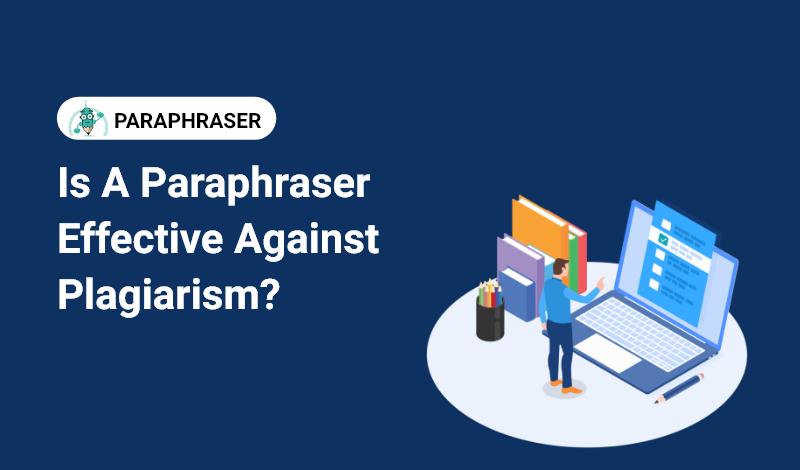
Is a Paraphraser Effective Against Plagiarism?
In a nutshell, the answer to this question is yes. Paraphrasers can be very effective against plagiarism.
Obviously, we’re not going to leave it at that. We wouldn’t have started this whole post if we just wanted to give this question a two-sentence answer.
We're going to go into detail about what plagiarism is, what paraphrasers are, how they work and how they can be effective against plagiarism.
Let’s get started.
What is Plagiarism?
Although it’s very likely that you already know about plagiarism as well as its different types, we’re going to go over it again to set some groundwork for the coming discussion.
Plagiarism can be defined as the practice of taking and using someone else's content as your own without giving them the due credit and acknowledgement. Plagiarism can be thought of as a type of stealing, which involves the theft of 'intellectual property', so to say.
There are different types of plagiarism that differ vis-à-vis the method of perpetration. For example, some common types of plagiarism are as follows:
- Direct plagiarism
- Mosaic plagiarism
- Source-based plagiarism
- Accidental plagiarism
Let’s take one of these for an explanation.
In direct plagiarism, the content is taken from a source without any sort of editing or altering. Although duplicitous, this duplication (see what we did there?) is easy to detect and there’s not much good that it can do for anyone nowadays.
We sure would have liked to go into detail about the other types of plagiarism as well, but we don’t want to go off-track. We want to come back to the topic at hand.
What are Paraphrasers and How Do They Work?
Paraphrasers are pretty much what they sound like. They are online tools…that paraphrase content.
Basically, paraphrasing tools (or paraphrasers, take your pick) run on several different algorithms. These algorithms can, depending on the tool, consist of AI models such as NLP and GPT-3.
With the help of these models, the paraphrasing tool is able to understand the text that is provided to them. Then, the tools make changes to the content by replacing some of the words with their synonyms, shuffling the sentence structures and altering the phrases etc.
The above is, by the way, neither applicable nor present in every paraphrasing tool available online. Some of them have a simple and dry working without a lot of AI integration. But those types of tools are, in all frankness, not worth using.
So, to help you understand the working of a paraphraser in a bit more detail, let’s do a little demonstration.
Here is a piece of text that we’re going to be running through a paraphrasing tool:
The chef came holding a butcher knife in one hand, his whole apron covered in red. Seeing him, the customers ran out yelling and shouting in terror. “Is tomato sauce that scary?” the chef asked the manager. “No, you moron. You’re in the wrong building.” Then, the chef realized he had walked into an IKEA instead of the deli next door.
Yep, that looks good. Although the passage may look random, it’s actually written this way so that there are several verbs in there. This will help us in seeing the working of the tool better.

Now, take a look at the output that we got from this tool. It is, to be fair, pretty smart and intelligent.
The words “his whole apron covered in red” was changed to “his apron completely red”. The words “shouting in terror” was simply changed to “horrified”.
And, there is also another little factor that we'd like to bring to your attention. In the input, the words "his deli…" are written grammatically incorrectly. But, in the output, you can see that the tool automatically corrected it to "the deli…” The same goes for a couple of other grammar errors in there as well which can be checked by grammar checker.
This grammar/spell correction is another little perk that you can enjoy with some paraphrasing tools.
The purpose of this whole demonstration was to just show you how paraphrasers work. Now that we’re clear about that, we can move on to the actual point and purpose of this post.
How Are Paraphrasers Effective Against Plagiarism?
Once again, if we want to give this question a short and brief answer, we can suffice by saying that paraphrasers are effective against plagiarism since they allow you to make such changes to a piece of plagiarized text that remove the exact replication from it, thus rendering it unique.
That was a long sentence. Let’s dumb it down a little.
Plagiarism means copied content. Content that is found to be copied has to be changed. This is so that the “copy-ness” is removed. Paraphrasers can make changes to the text. The copied content becomes…uncopied.
By the way, we should take the time to mention here that it is allowed to use a paraphrasing tool for taking care of plagiarism only if the latter happens to the accidental and unintentional. Taking some content from a source and then running it through a paraphraser for your personal use is neither ethical nor befitting any honest writer. Paraphrasing tool can be handy for copywriters to generate content.
Coming back to the point, let’s elaborate a little on the question of how paraphrasing tools are effective against plagiarism.
-
Paraphrasers Can Help with Plagiarism Thanks to The “Synonymizing”
In a lot of cases, a sentence or line that is showing up as plagiarized can be made “unique” by simply changing a couple of words with their synonyms.
Here, let’s take an example. We’re going to use a plagiarism checker to find if a particular sentence is unique or not. This is the sentence that we’re going to be using:
“Our tool is using advanced AI technology that checks your content to in-depth search for all similarities and duplication to other online sources.”
And yes, this sentence is taken from our own website, which is why it will show up as plagiarized:

Now, from this whole sentence, we’re going to edit only three words…like this:
“Our tool is using high-end AI technology that checks your write-up to in-depth search for all similarities and plagiarism to other online sources.”
If we take this sentence and run it through the same plagiarism checker, we’ll get a “100% Unique” output.

In this same way, a paraphraser can help you eliminate accidental and unintentional plagiarism from your writing by replacing specific words with suitable synonyms.
As we saw in the demonstration earlier on, a paraphrasing tool changes a lot more than just a couple of words. So, your content will be safely free from plagiarism once you run it through a tool.
-
Sentence Structure Modification
As we mentioned earlier, there are different types of paraphrasing tools available online. Some of them integrate AI in their functionality and have an intelligent working while others are a tad simple.
Changing words with synonyms is something that is done by every paraphrasing tool, no matter how basic. Yes, the accuracy and smartness of the results depend on how good the tool is.
However, other than word-changing, there is also another kind of alteration that paraphrasing tools can make to the given text i.e., sentence structure modification.
This is actually what we saw in our demonstration above. We'll bring that image back here once again for reiteration.

In this particular passage, take a little look-see at the words “…his whole apron covered in red…” (We actually pointed out this very same thing earlier as well.)
In the output, these words are considerably shortened by the tool and are written as “…his apron completely red…”
This gimmick i.e., sentence modification will obviously be seen to a much greater degree when the content happens to be long and lengthy. But, our example suffices to show just how it can alter a piece of text to make it look different…which, in turn, renders it plagiarism-free.
-
Paraphrasers Can Change Phrases in the Given Text
Paraphrasers can also change the phrases in the given text by either shortening them or replacing them with a suitable synonym. This is not to be confused with the synonymizing stuff that we discussed earlier. When the tool changes the words with their synonyms, it replaces a single word with another alternative.
But when the phrases are changed, a couple of words are collectively replaced with a single word.
Here, take a look at this screenshot:

In the first line, the words were “…or by replacing them…” The tool simply changed the tense and reworded the words as “…or replace them…”
Get our point?
How to Use a Paraphraser Effectively Against Plagiarism?
Well, we’ve covered how paraphrasers are effective against plagiarism. Now, before wrapping this post up, let’s look at some tips on how you can effectively use them for yourself.
1. Make Sure to Pick a Good Paraphraser
If you want to use a paraphraser to effectively get rid of plagiarism, you have to make sure that you pick a good one. As we mentioned a couple of times above, not all paraphrasing tools work the same, and not all of them provide satisfactory results.
To find a good one for yourself, you can simply search the internet for blog posts like “Top five paraphrasers” or “Best five paraphrasers” …or something along those lines.
These types of blog posts can help you get an idea about some popular tools as well as their features. It’s not always wise to trust the verdicts given by such posts…since they can be sponsored, in a lot of cases.
However, you can use them to find some paraphrasing tools, which you can later try out yourself.
2. Use the Right Modes
Basically, some paraphrasers provide a number of modes that work differently. One of the offered modes can affect a small number of changes to the given text whereas one of them can make a lot of heavy alterations.
Here, check this out:

In the screenshot above, you can see that we’ve used one of the basic modes provided by the paraphraser. As such, the changes made to the text are somewhat basic, and they don’t flow well.
Now, if we take this same content and put it in the same tool but choose a different mode, we get the following results:

So, when using a tool that offers multiple modes, be sure to pick one (a mode) that makes those types of changes to the text that you require.
3. Always Take Care to Check the Outputs
While it is good to take help from paraphrasing tools for getting rid of plagiarism, you can’t be too trusting. Paraphrasers are, after all, automated software. They can make errors.
Whenever you want to paraphrase some lines or sentences, be sure to always proofread them afterwards. If there are any contextual discrepancies in there, you will be able to find and remove them before finalization.
Conclusion
And that brings this post to a close.
Paraphrasers can be helpful in eliminating plagiarism from a piece of content. However, when you want to use one of them for this purpose, you have to take care of different things such as choosing the right tool, using the right mode and so on.
In this post, we covered a lot of stuff. Hopefully, you know more about paraphrasers, how they work and how you can use them against plagiarism.

